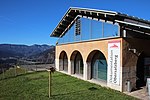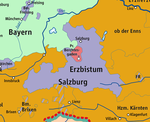Berghof (residence)

The Berghof was Adolf Hitler's holiday home in the Obersalzberg of the Bavarian Alps near Berchtesgaden, Bavaria, Germany. Other than the Wolfsschanze ("Wolf's Lair"), his headquarters in East Prussia for the invasion of the Soviet Union, he spent more time here than anywhere else during his time as the Führer of Nazi Germany. It was also one of the most widely known of his headquarters, which were located throughout Europe. The Berghof was rebuilt and renamed in 1935 and was Hitler's holiday residence for ten years. It was damaged by British bombs in late April 1945, and again in early May by retreating SS troops, and it was looted after Allied troops reached the area. The Bavarian government demolished the burned shell in 1952.
Excerpt from the Wikipedia article Berghof (residence) (License: CC BY-SA 3.0, Authors, Images).Berghof (residence)
Lindeweg,
Geographical coordinates (GPS) Address Nearby Places Show on map
Geographical coordinates (GPS)
| Latitude | Longitude |
|---|---|
| N 47.633611111111 ° | E 13.041944444444 ° |
Address
Lindeweg
Lindeweg
83471
Bavaria, Germany
Open on Google Maps










